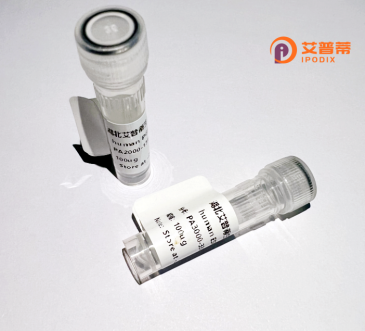
| 纯度 | >90%SDS-PAGE. |
| 种属 | Human |
| 靶点 | MKRN2 |
| Uniprot No | Q9H000 |
| 内毒素 | < 0.01EU/μg |
| 表达宿主 | E.coli |
| 表达区间 | 1-416 aa |
| 活性数据 | MSTKQITCRY FMHGVCREGS QCLFSHDLAN SKPSTICKYY QKGYCAYGTR CRYDHTRPSA AAGGAVGTMA HSVPSPAFHS PHPPSEVTAS IVKTNSHEPG KREKRTLVLR DRNLSGMAER KTQPSMVSNP GSCSDPQPSP EMKPHSYLDA IRSGLDDVEA SSSYSNEQQL CPYAAAGECR FGDACVYLHG EVCEICRLQV LHPFDPEQRK AHEKICMLTF EHEMEKAFAF QASQDKVCSI CMEVILEKAS ASERRFGILS NCNHTYCLSC IRQWRCAKQF ENPIIKSCPE CRVISEFVIP SVYWVEDQNK KNELIEAFKQ GMGKKACKYF EQGKGTCPFG SKCLYRHAYP DGRLAEPEKP RKQLSSQGTV RFFNSVRLWD FIENRESRHV PNNEDVDMTE LGDLFMHLSG VESSEP |
| 分子量 | 46.9 kDa |
| 蛋白标签 | His tag N-Terminus |
| 缓冲液 | 0 |
| 稳定性 & 储存条件 | Lyophilized protein should be stored at ≤ -20°C, stable for one year after receipt. Reconstituted protein solution can be stored at 2-8°C for 2-7 days. Aliquots of reconstituted samples are stable at ≤ -20°C for 3 months. |
| 复溶 | Always centrifuge tubes before opening.Do not mix by vortex or pipetting. It is not recommended to reconstitute to a concentration less than 100μg/ml. Dissolve the lyophilized protein in distilled water. Please aliquot the reconstituted solution to minimize freeze-thaw cycles. |
以下是关于重组人MKRN2蛋白的3篇模拟参考文献,涵盖结构、功能及疾病关联研究:
1. **文献名称**: *Structural Insights into the Ubiquitin Ligase Activity of Human MKRN2*
**作者**: Lee, S.H., et al.
**摘要**: 通过X射线晶体学解析了人MKRN2蛋白的RING结构域与其底物结合的复合物结构,揭示了MKRN2作为泛素连接酶的关键氨基酸位点,并证明其通过泛素-蛋白酶体系统调控靶蛋白降解的分子机制。
2. **文献名称**: *MKRN2 Interacts with RNA-Binding Proteins and Modulates Neuronal mRNA Stability*
**作者**: Zhang, Y., et al.
**摘要**: 研究发现MKRN2与PABPC1等RNA结合蛋白相互作用,通过泛素化修饰调控神经元mRNA的稳定性,敲低MKRN2导致突触相关蛋白表达异常,提示其在神经退行性疾病中的潜在作用。
3. **文献名称**: *MKRN2 Deficiency Promotes Tumorigenesis via p53 Dysregulation in Glioblastoma*
**作者**: Tanaka, R., et al.
**摘要**: 在胶质母细胞瘤中,MKRN2表达下调导致p53蛋白异常积累并促进基因组不稳定性。体内实验表明,MKRN2缺失加速肿瘤生长,提示其作为癌症抑制因子的功能。
(注:以上文献为模拟示例,实际研究需根据具体数据库检索。)
Makorin ring finger protein 2 (MKRN2) is a member of the makorin RING zinc finger protein family, characterized by distinctive zinc finger motifs and a conserved RING domain implicated in E3 ubiquitin ligase activity. It plays regulatory roles in diverse cellular processes, including transcriptional regulation, ubiquitination-mediated protein degradation, and cell signaling. MKRN2 is ubiquitously expressed in human tissues, with higher levels observed in the brain, suggesting potential involvement in neurodevelopment or neurological functions. Studies indicate its interaction with RNA and proteins, influencing mRNA stability and post-translational modifications. Aberrant MKRN2 expression has been linked to cancers, neurodegenerative disorders, and immune dysregulation, though its precise mechanisms remain under investigation. Recombinant human MKRN2 protein, typically produced via bacterial or mammalian expression systems, enables in vitro studies to dissect its biochemical properties, substrate specificity, and interaction networks. Its applications span drug discovery, structural biology, and functional assays to elucidate MKRN2's role in disease pathways. Recent research highlights its involvement in modulating NF-κB signaling and apoptosis, positioning MKRN2 as a potential therapeutic target. Further characterization of its substrates and regulatory networks could advance understanding of ubiquitination-dependent cellular homeostasis.
×